The Observed Impact of the South Asian Summer Monsoon on Land-Atmosphere Heat Transfers and Its Inhomogeneity over the Tibetan Plateau
Abstract
:1. Introduction
2. Data and Methods
3. Results
3.1. SASM Evolution and Synoptic Situations
3.2. The Impacts of SASM Evolution on the Radiation Heat Transfers
3.3. The Impacts of SASM Evolution on the Turbulent Heat Transfers
4. Discussion
5. Conclusions
Author Contributions
Funding
Data Availability Statement
Acknowledgments
Conflicts of Interest
References
- Ye, D.; Gao, Y. Meteorology of the Qinghai-Xizang Plateau; Science Press: Beijing, China, 1979; p. 279. [Google Scholar]
- Yanai, M.; Li, C.; Song, Z. Seasonal heating of the Tibetan Plateau and its effects on the evolution of the Asian summer monsoon. J. Meteorol. Soc. Jpn. 1992, 70, 319–351. [Google Scholar] [CrossRef] [Green Version]
- Wu, G.; Zhang, Y. Tibetan Plateau forcing and the timing of the monsoon onset over South Asia and the South China Sea. Mon. Weather Rev. 1998, 126, 913–927. [Google Scholar] [CrossRef]
- Zhou, X.; Zhao, P.; Chen, J.; Chen, L.; Li, W. Impacts of thermodynamic processes over the Tibetan Plateau on the Northern Hemispheric climate. Sci. China Ser. D Earth Sci. 2009, 52, 1679–1693. [Google Scholar] [CrossRef]
- Zou, H. Seasonal variation and trends of TOMS ozone over Tibet. Geophys. Res. Lett. 1996, 23, 1029–1032. [Google Scholar] [CrossRef]
- Gao, Z.; Wang, J.; Ma, Y.; Kim, J.; Choi, T.; Lee, H.; Asanuma, J.; Su, Z. Calculation of near-surface layer turbulent transport and analysis of surface thermal equilibrium features in Nagqu of Tibet. Phys. Chem. Earth B 2000, 25, 135–139. [Google Scholar] [CrossRef]
- Bian, L.; Gao, Z.; Xu, Q.; Lu, L.; Cheng, Y. Measurements of turbulence transfer in the near-surface layer over the Southeastern Tibetan Plateau. Bound. Layer Meteorol. 2002, 102, 281–300. [Google Scholar] [CrossRef]
- Li, J.; Hong, Z.; Luo, W.; Li, A.; Zhao, Y. A study of surface fluxes in Gerze area, Qinghai-Xizang Plateau. Chin. J. Atmos. Sci. 1999, 23, 142–151. [Google Scholar]
- Zou, H.; Ma, S.; Zhou, L.; Li, P.; Li, A. Measured turbulent heat transfer on the northern slope of Mt. Everest and its relation to the south Asian summer monsoon. Geophys. Res. Lett. 2009, 36, L09810. [Google Scholar] [CrossRef]
- Zou, H.; Li, P.; Ma, S.; Zhou, L.; Zhu, J. The local atmosphere and the turbulent heat transfer in the eastern Himalayas. Adv. Atmos. Sci. 2012, 29, 435–440. [Google Scholar] [CrossRef]
- Li, C.; Yanai, M. The onset and interannual variability of the Asian summer monsoon in relation to land-sea thermal contrast. J. Clim. 1996, 9, 358–375. [Google Scholar] [CrossRef] [Green Version]
- Webster, P.; Magaña, V.; Palmer, T.; Shukla, J.; Tomas, R.; Yanai, M.; Yasunari, T. Monsoons: Processes, predictability, and the prospects for prediction. J. Geophys. Res. 1998, 103, 14451–14510. [Google Scholar] [CrossRef]
- Hsu, H.; Terng, C.; Chen, C. Evolution of large-scale circulation and heating during the first transition of Asian summer monsoon. J. Clim. 1999, 12, 793–810. [Google Scholar] [CrossRef]
- Goswami, B.; Mohan, R.A.; Xavier, P.; Sengupta, D. Clustering of low pressure systems during the Indian summer monsoon by intraseasonal oscillations. Geophys. Res. Lett. 2003, 30, 1431. [Google Scholar] [CrossRef] [Green Version]
- Goswami, B.; Xavier, P. Potential predictability and extended range prediction of Indian summer monsoon breaks. Geophys. Res. Lett. 2003, 30, 1966. [Google Scholar] [CrossRef] [Green Version]
- He, H.; McGinnis, J.; Song, Z.; Yanai, M. Onset of the Asian summer monsoon in 1979 and the effect of the Tibetan Plateau. Mon. Weather Rev. 1987, 115, 1966–1995. [Google Scholar] [CrossRef]
- Zhou, L.; Zou, H.; Ma, S.; Li, P. Observed impact of the South Asian summer monsoon on the local meteorology in the Himalayas. Acta Meteorol. Sin. 2012, 26, 205–215. [Google Scholar] [CrossRef]
- Krishnamurti, T.; Ardanuy, P. The 10 to 20 day westward propagating mode and breaks in the monsoon. Tellus 1980, 32, 15–26. [Google Scholar] [CrossRef] [Green Version]
- Krishnamurthy, V.; Shukla, J. Intraseasonal and interannual variability of rainfall over India. J. Clim. 2000, 13, 4366–4377. [Google Scholar] [CrossRef]
- Ding, Y.; Sikka, D. Synoptic systems and weather. In The Asian Monsoon; Wang, B., Ed.; Praxis Publishing Ltd.: Chichester, UK, 2006; pp. 131–202. [Google Scholar]
- Gao, D.; Zou, H.; Wang, W. Influences of Brahmaputra river water passage on the precipitation. Mountain Res. 1985, 3, 239–249. [Google Scholar]
- Zhou, L.; Zou, H.; Ma, S.; Li, P.; Wu, R. Impacts of the South Asian Summer Monsoon on Variations of Surface Wind on the Northern Slope of Mt. Qomolangma. Plateau Meteorol. 2007, 26, 1173–1186. [Google Scholar]
- Zhou, L.; Zou, H.; Ma, S.; Li, P. Study on impact of the South Asian summer monsoon on the down-valley wind on the north slope of Mt. Everest. Geophys. Res. Lett. 2008, 35, L14811. [Google Scholar] [CrossRef]
- Zhou, L.; Zhu, J.; Zou, H.; Ma, S.; Li, P.; Zhang, Y.; Huo, C. Atmospheric moisture distribution and transport over the Tibetan Plateau and the impacts of the South Asian summer monsoon. Acta Meteorol. Sin. 2013, 27, 819–831. [Google Scholar] [CrossRef]
- Zhou, L.; Li, F.; Zhu, J.; Zou, H.; Ma, S.; Li, P. Vertical structures of atmospheric properties in Southeast Tibet during the South Asian summer monsoon in 2013. J. Meteorol. Res. 2016, 30, 258–264. [Google Scholar] [CrossRef]
- Li, J.; Li, Y.; Jiang, X.; Gao, D. Characteristics of land–atmosphere energy exchanges over complex terrain area of southeastern Tibetan Plateau under different weather conditions. Chin. J. Atmos. Sci. 2016, 40, 777–791. [Google Scholar]
- Zhou, L.; Zou, H.; Ma, S.; Li, F.; Zhu, J.; Li, P.; Zhang, Y. The observed impacts of South Asian summer monsoon on the local atmosphere and the near surface turbulent heat exchange over the Southeast Tibet. J. Geophys. Res. Atmos. 2015, 120, 11509–11518. [Google Scholar] [CrossRef] [Green Version]
- Zhao, P.; Xu, X.; Chen, F.; Guo, X.; Zheng, X.; Liu, L.; Hong, Y.; Li, Y.; La, Z.; Peng, H.; et al. The third atmospheric scientific experiment for understanding the earth–atmosphere coupled system over the Tibetan plateau and its effects. Bull. Amer. Meteor. Soc. 2018, 99, 757–776. [Google Scholar] [CrossRef]
- Wang, Y.; Xu, X.; Liu, H.; Li, Y.; Li, Y.; Hu, Z.; Gao, X.; Ma, Y.; Sun, J.; Lenschow, D.H.; et al. Analysis of land surface parameters and turbulence characteristics over the Tibetan Plateau and surrounding region. J. Geophys. Res. Atmos. 2016, 121, 9540–9560. [Google Scholar] [CrossRef]
- Tanner, C.; Thurtell, G. Anemoclinometer Measurements of Reynolds Stress and Heat Transport in the Atmospheric Surface Layer; Research and Development Technical Report, ECOM 66-G22-F; Department of Soil Science, University of Wisconsin: Madison, WI, USA, 1969; p. 82. [Google Scholar]
- Webb, E.K.; Pearman, G.I.; Leuning, R. Correction of flux measurements for density effects due to heat and water vapour transfer. Q. J. R. Meteor. Soc. 1980, 106, 85–100. [Google Scholar] [CrossRef]
- Zhou, L.; Zou, H.; Ma, S.; Li, P.; Zhu, J.; Huo, C. Vertical air mass exchange driven by the local circulation on the northern slope of Mount Everest. Adv. Atmos. Sci. 2011, 28, 217–222. [Google Scholar] [CrossRef]
- Soman, M.; Kumar, K. Space-time evolution of meteorological features associated with the onset of Indian summer monsoon. Mon. Weather. Rev. 1993, 121, 1177–1194. [Google Scholar] [CrossRef] [Green Version]
- Wang, B.; Wu, R.; Lau, K. Interannual variability of the Asian summer monsoon: Contrasts between the Indian and the western North Pacific–East Asian monsoons. J. Clim. 2001, 14, 4073–4090. [Google Scholar] [CrossRef]
- Zhao, P.; Li, Y.; Guo, X.; Xu, X.; Liu, Y.; Tang, S.; Xiao, W.; Shi, C.; Ma, Y.; Yu, X.; et al. The Tibetan Plateau surface-atmosphere coupling system and its weather and climate effect: The Third Tibetan Plateau Atmospheric Scienticfic Experiment. Acta Meteorol. Sin. 2018, 76, 833–860. [Google Scholar] [CrossRef]
- Yang, K.; Guo, X.; He, J.; Qin, J.; Koike, T. On the climatology and trend of the atmospheric heat source over the Tibetan Plateau: An experiments-supported revisit. J. Clim. 2011, 24, 1525–1541. [Google Scholar] [CrossRef]
- Zhao, P.; Chen, L. Climatic features of atmospheric heat source/sink over the Qinghai-Xizang Plateau in 35 years and its relation to rainfall in China. Sci. China Ser. D Earth Sci. 2001, 44, 858–864. [Google Scholar] [CrossRef]
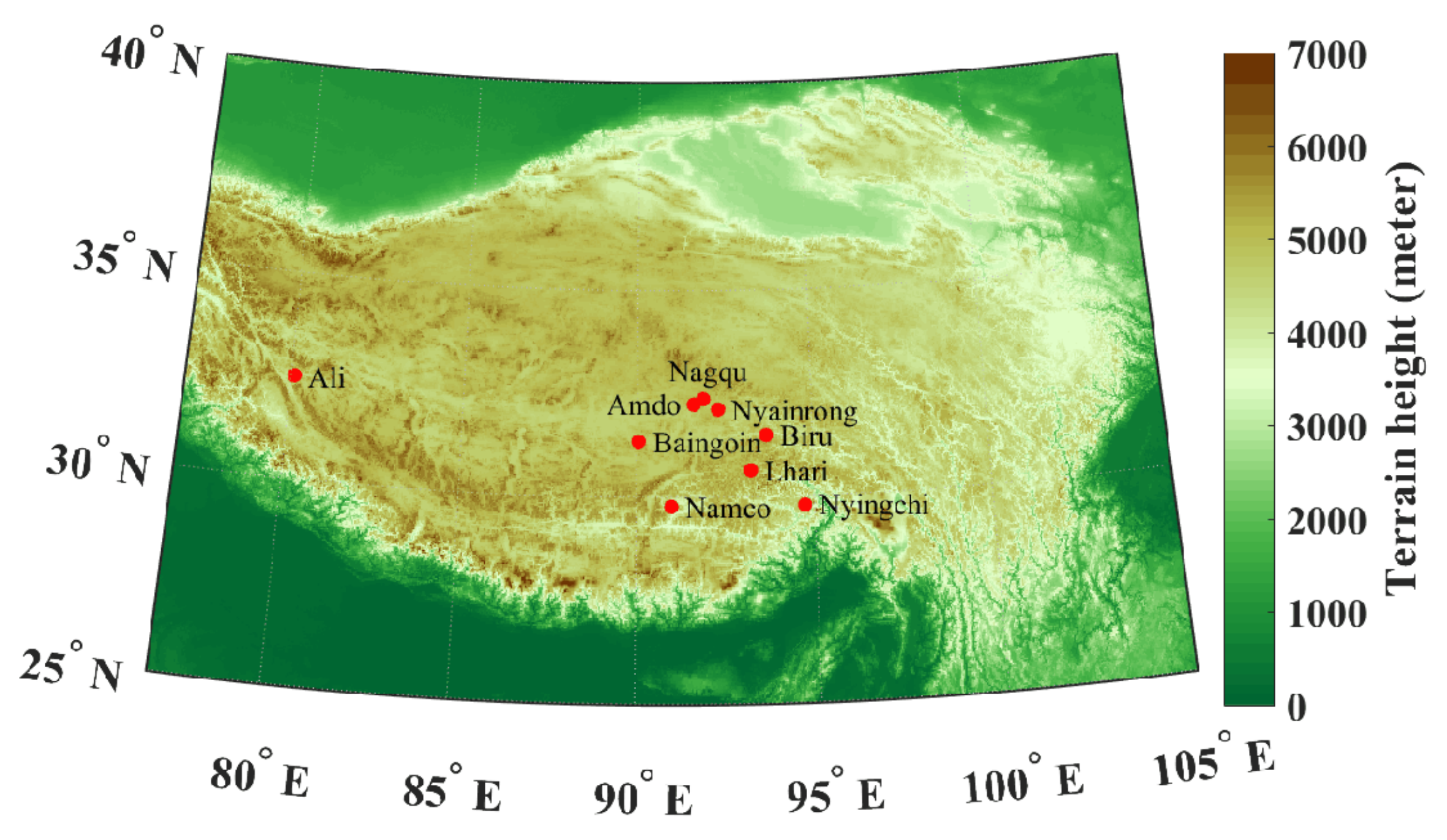
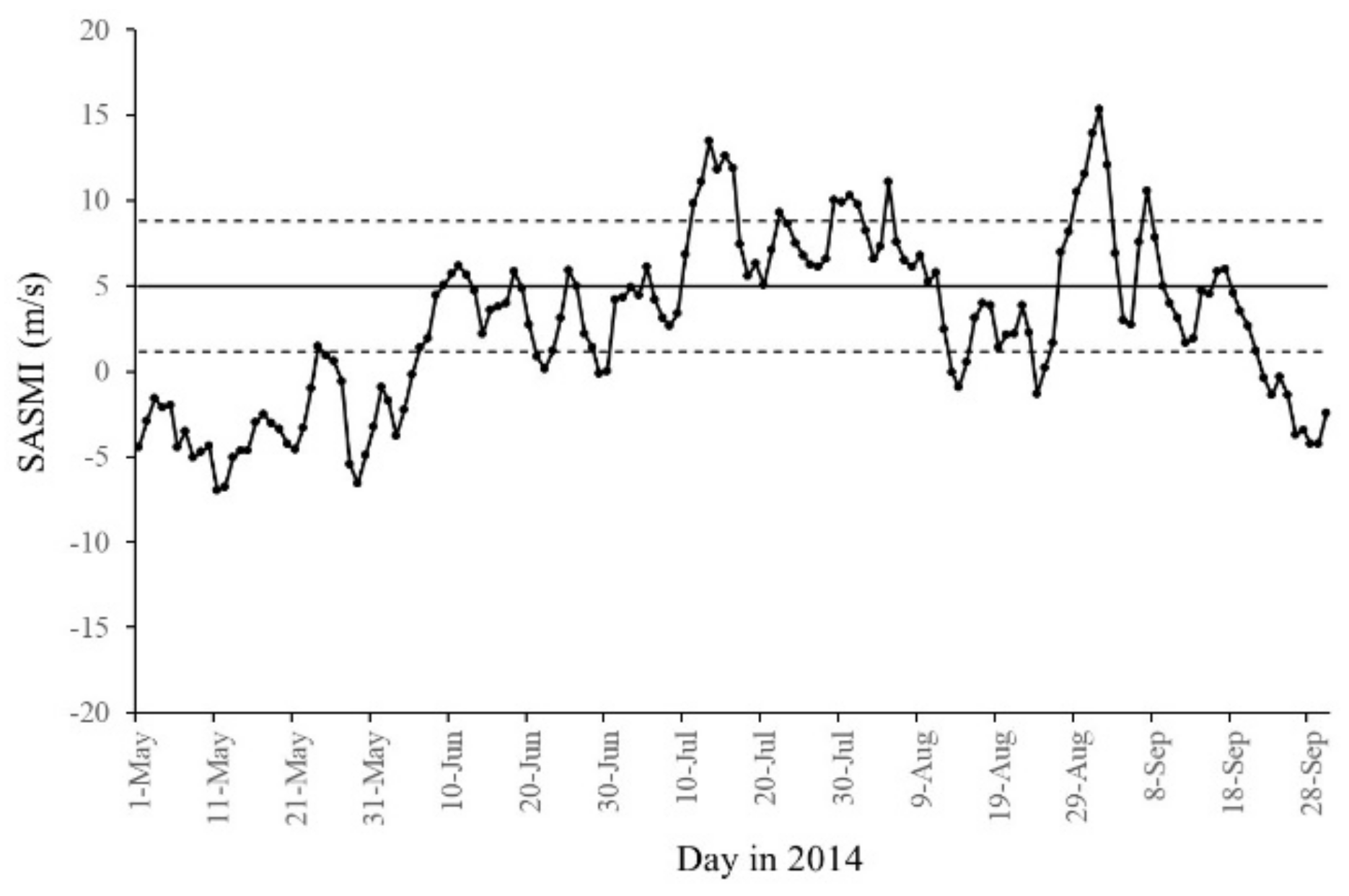
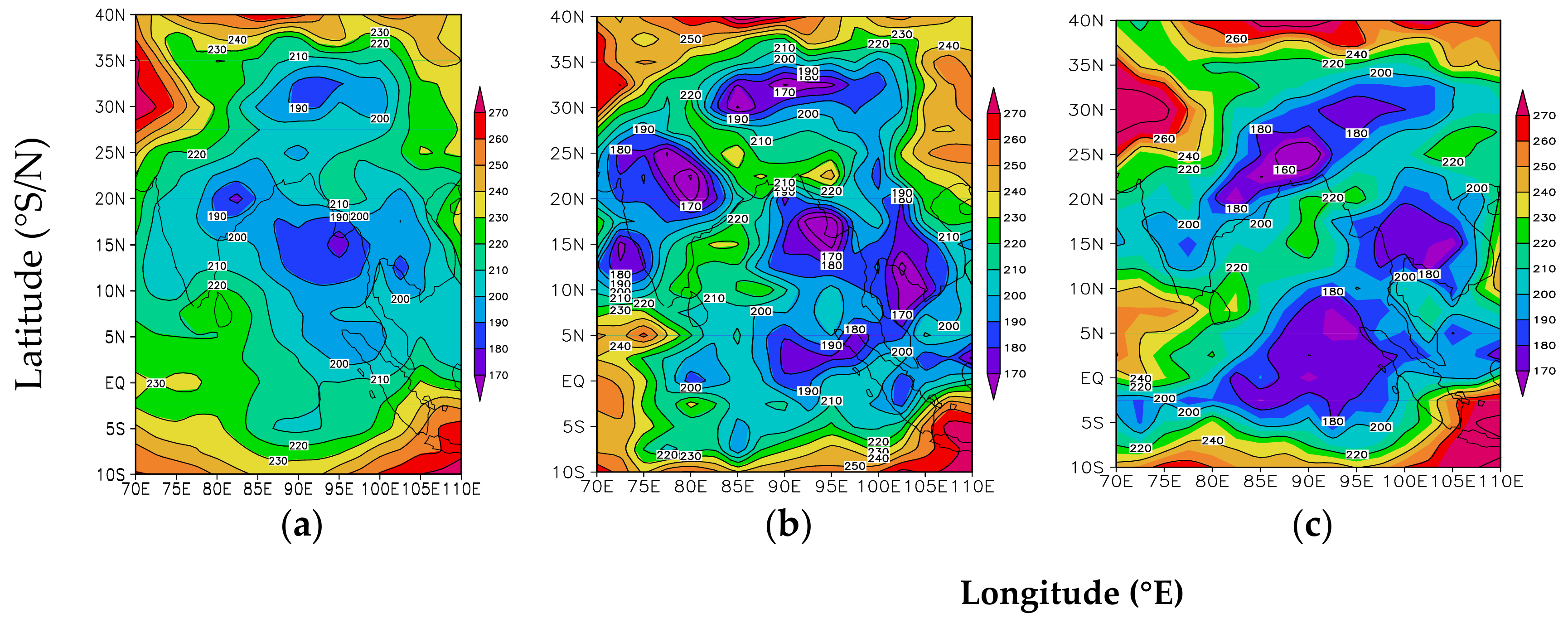

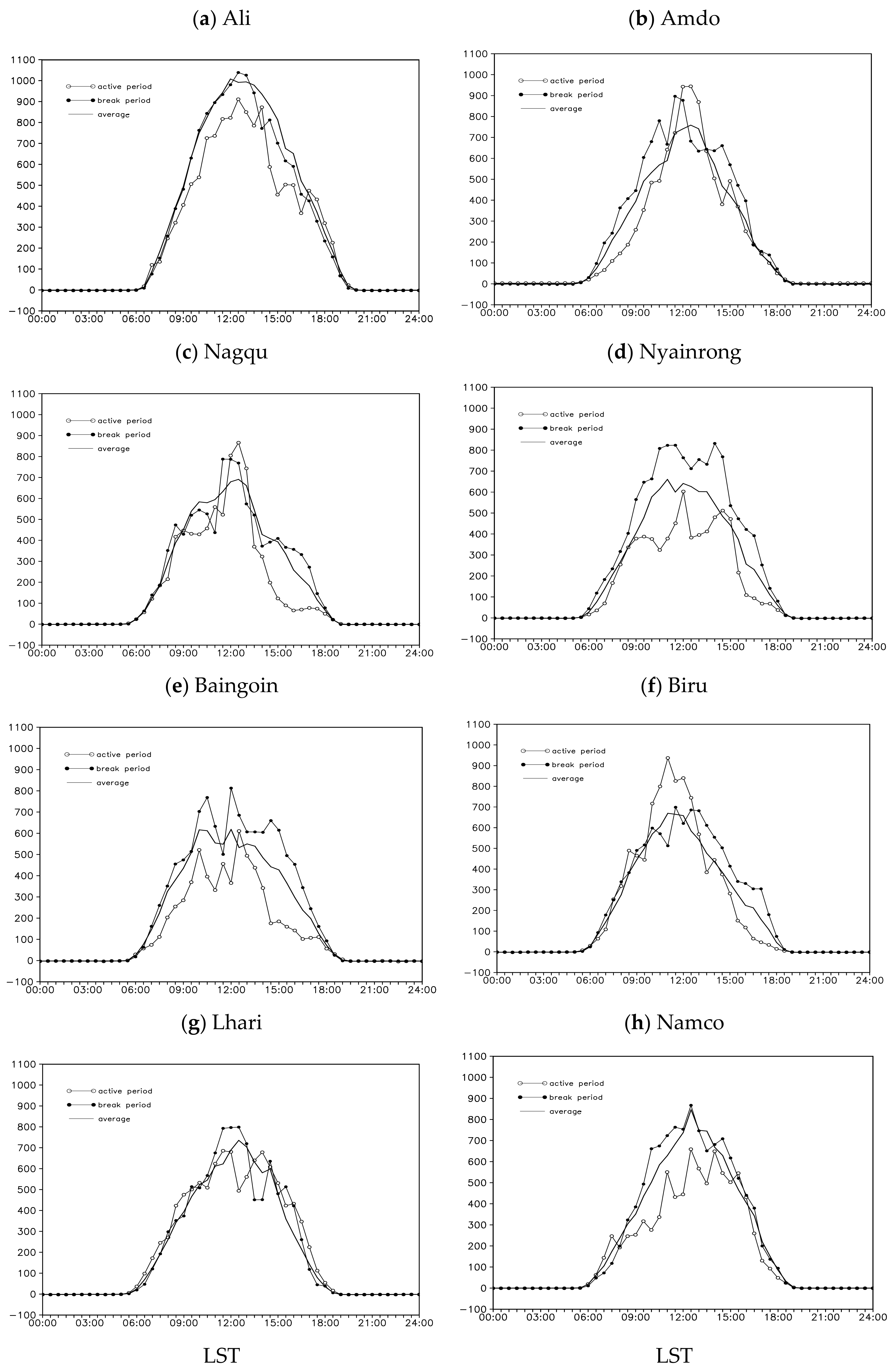
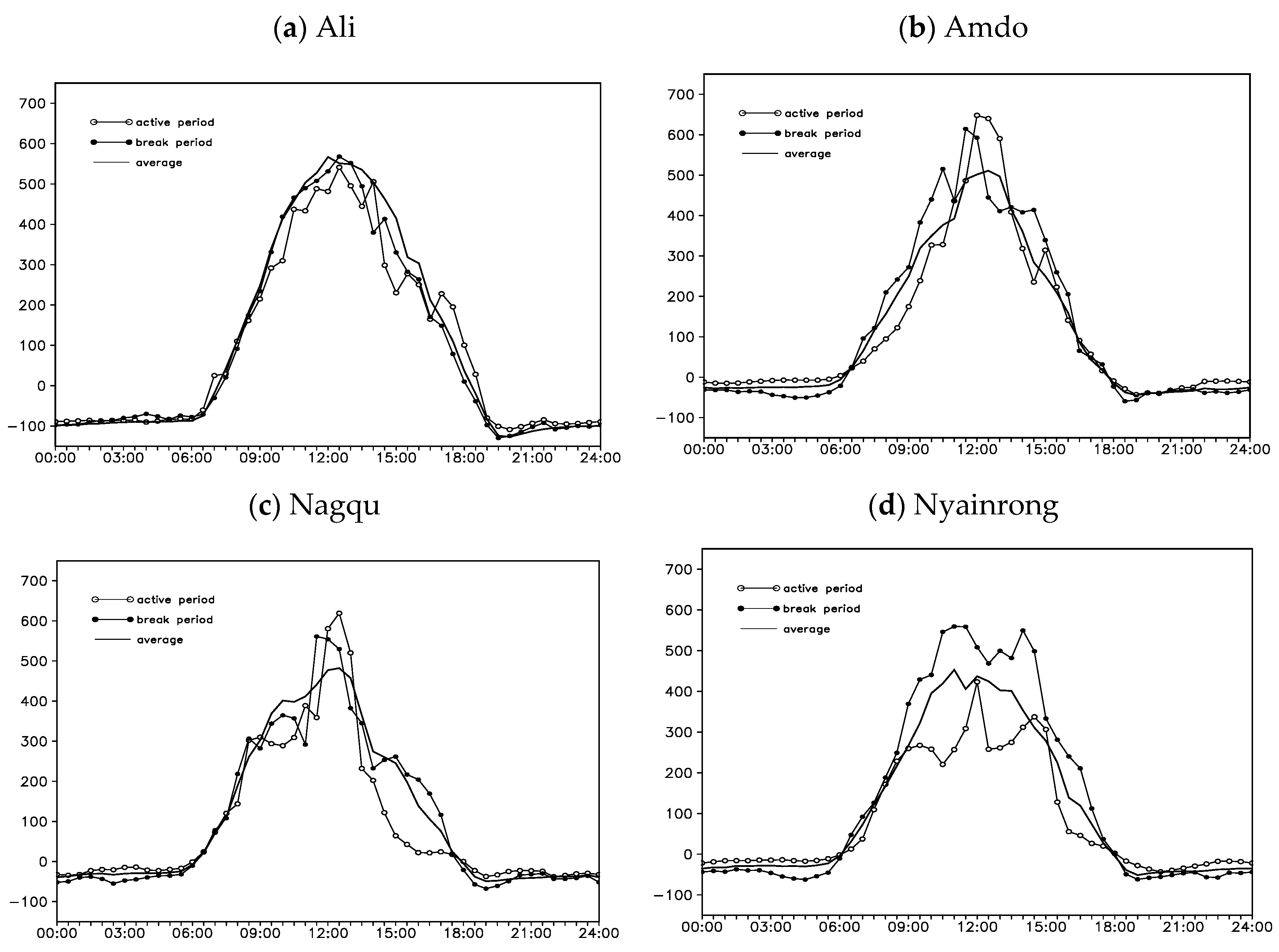
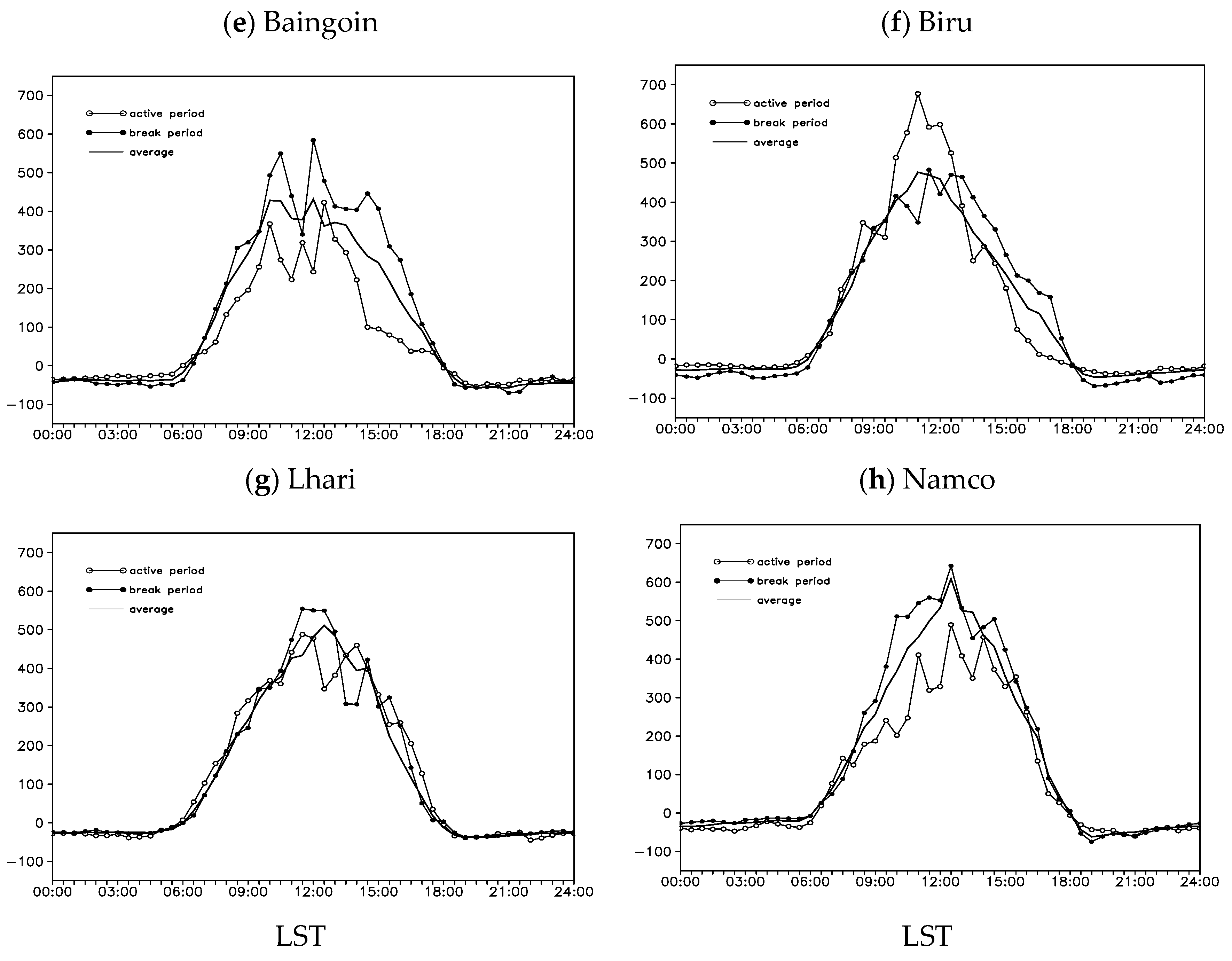
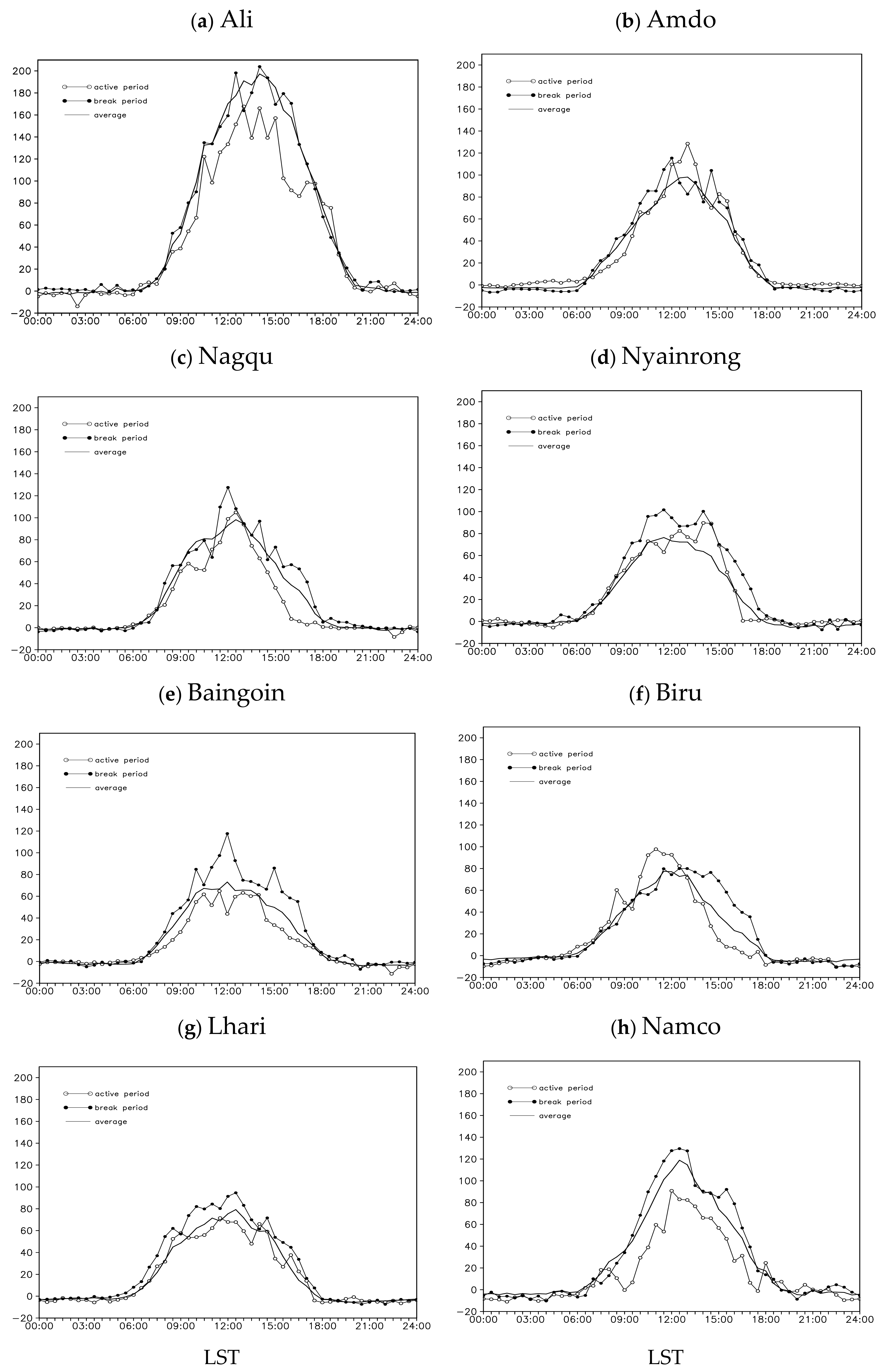
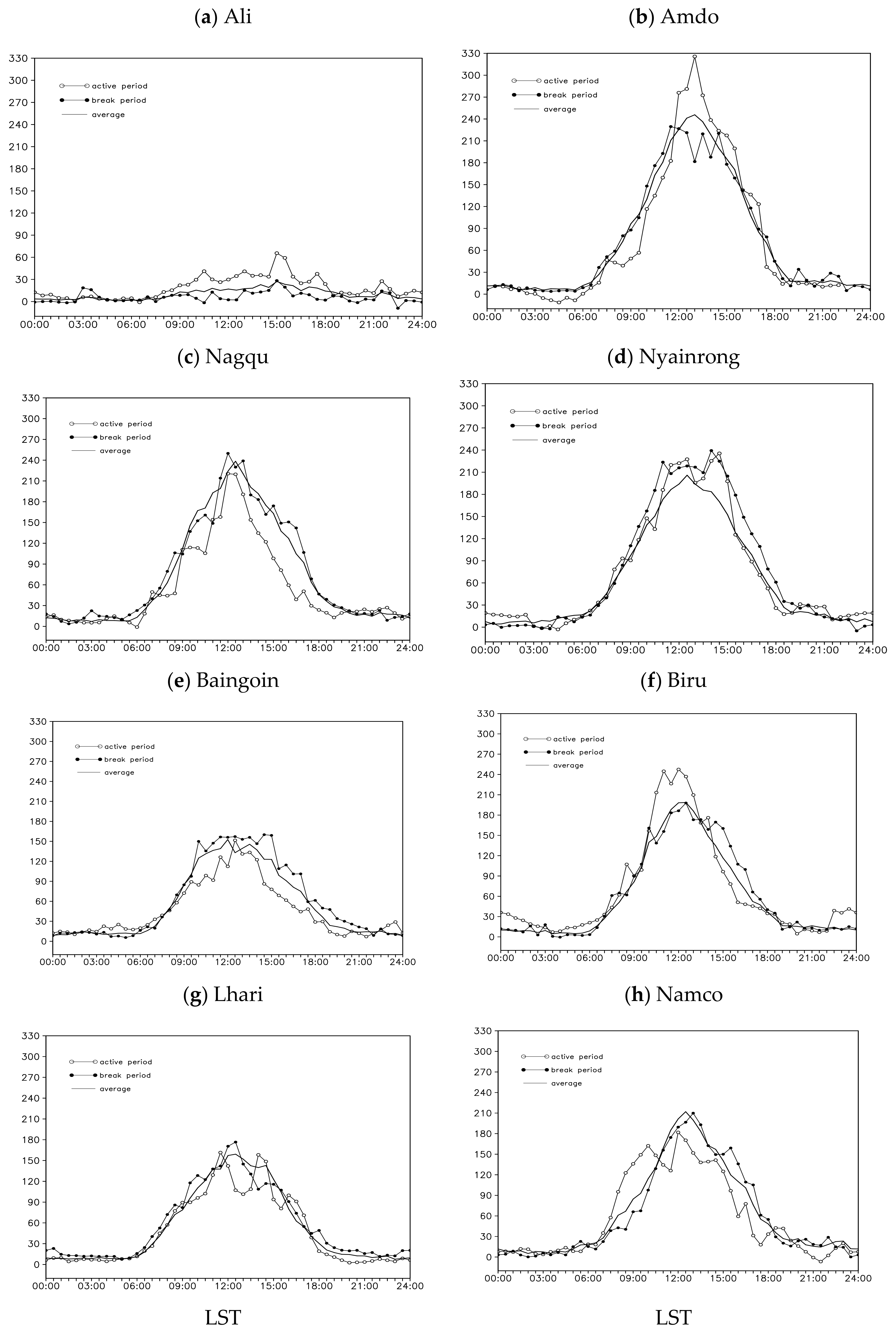
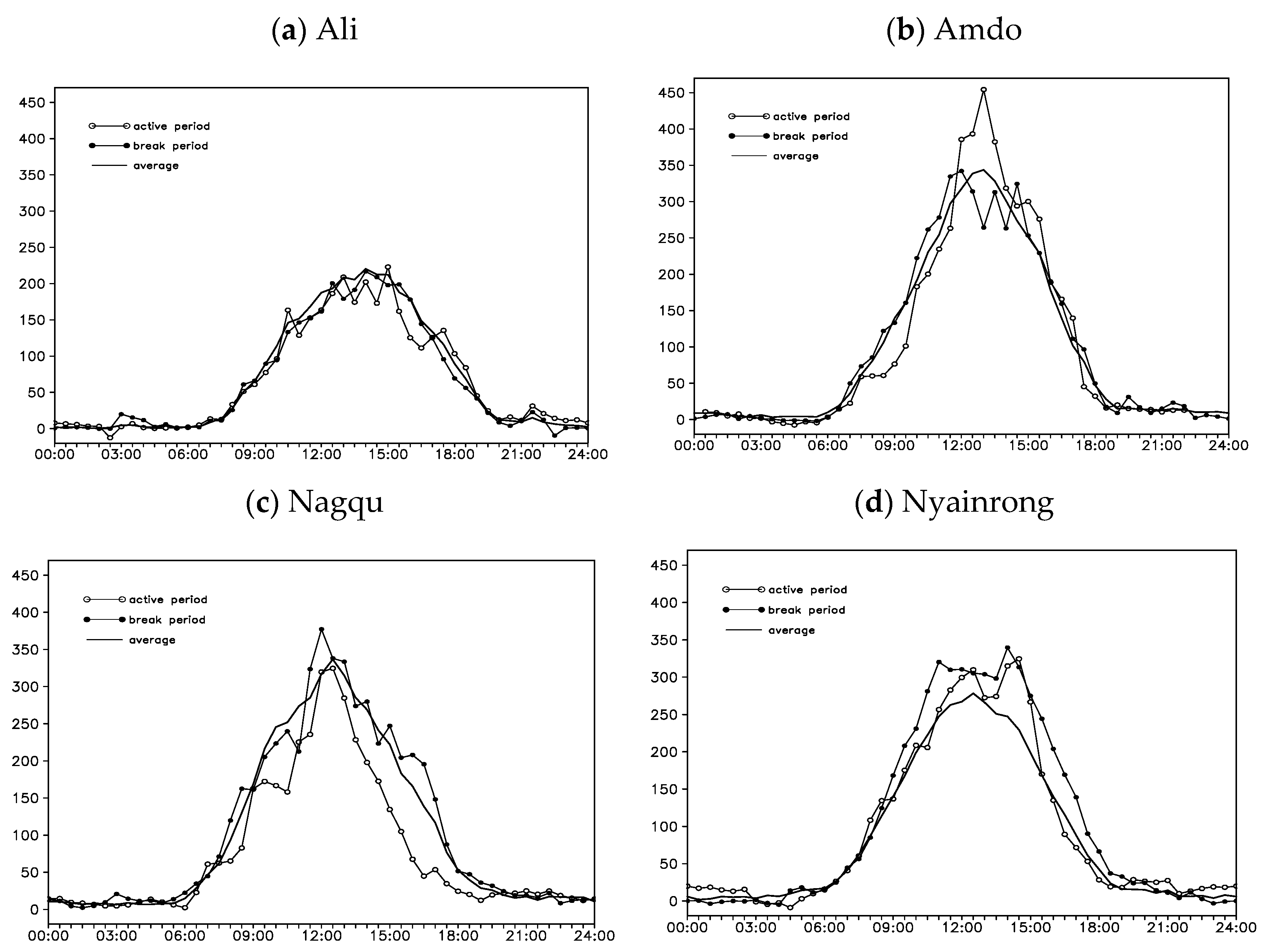

| Stations | Location | Elevation (m) | Plateau Regions |
|---|---|---|---|
| Ali | 80.1°E, 32.5°N | 4350 | northwest plateau |
| Nagqu | 91.9°E, 32.4°N | 4509 | central plateau |
| Amdo | 91.6°E, 32.2°N | 4695 | central plateau |
| Nyainrong | 92.3°E, 32.1°N | 4730 | central plateau |
| Biru | 93.7°E, 31.5°N | 4408 | central plateau |
| Baingoin | 90.1°E, 31.4°N | 4700 | central plateau |
| Lhari | 93.2°E, 30.7°N | 4500 | central plateau |
| Namco | 91.0°E, 29.8°N | 4730 | southeast plateau |
| Nyingchi | 94.7°E, 29.8°N | 3327 | southeast plateau |
| SH/Stations | Ali | Nagqu | Amdo | Nyainrong | Biru | Baingoin | Lhari | Namco |
|---|---|---|---|---|---|---|---|---|
| Observation | 60.1 | 26.5 | 24.5 | 20.0 | 18.8 | 20.2 | 20.0 | 28.2 |
| SASM active | 47.7 (−20.5%) | 20.9 (−21.2%) | 27.5 (12.3%) | 22.6 (13.2%) | 18.5 (−1.7%) | 16.0 (−20.8%) | 18.6 (−6.8%) | 16.5 (−41.4%) |
| SASM break | 60.6 (0.8%) | 30.1 (13.4%) | 27.0 (10.1%) | 29.0 (45.3%) | 21.7 (15.4%) | 27.7 (37.6%) | 26.3 (31.7%) | 30.9 (9.7%) |
| LH/Stations | Ali | Nagqu | Amdo | Nyainrong | Biru | Baingoin | Lhari | Namco |
|---|---|---|---|---|---|---|---|---|
| Observation | 10.1 | 74.7 | 74.4 | 66.6 | 59.3 | 55.4 | 53.0 | 65.0 |
| SASM active | 18.9 (87.4%) | 56.8 (−24.0%) | 78.7 (5.9%) | 72.8 (9.4%) | 69.5 (17.3%) | 47.5 (−14.3%) | 48.3 (−8.8%) | 59.1 (−9.0%) |
| SASM break | 5.9 (−41.2%) | 77.5 (3.8%) | 73.5 (−1.1%) | 77.6 (16.6%) | 63.5 (7.1%) | 62.9 (13.6%) | 57.8 (9.0%) | 63.0 (3.0%) |
| TH/Stations | Ali | Nagqu | Amdo | Nyainrong | Biru | Baingoin | Lhari | Namco |
|---|---|---|---|---|---|---|---|---|
| Observation | 70.2 | 101.2 | 98.8 | 86.5 | 78.1 | 75.5 | 73.0 | 93.1 |
| SASM active | 66.7 (−5.0%) | 77.7 (−23.3%) | 108.7 (10.0%) | 95.4 (10.2%) | 88.0 (12.7%) | 63.4 (−16.0%) | 67.0 (−8.3%) | 75.6 (−18.8%) |
| SASM break | 66.5 (−5.2%) | 107.6 (6.3%) | 100.5 (1.7%) | 106.6 (23.2%) | 85.2 (9.1%) | 90.6 (20.0%) | 84.1 (15.2%) | 93.9 (0.8%) |
Publisher’s Note: MDPI stays neutral with regard to jurisdictional claims in published maps and institutional affiliations. |
© 2022 by the authors. Licensee MDPI, Basel, Switzerland. This article is an open access article distributed under the terms and conditions of the Creative Commons Attribution (CC BY) license (https://creativecommons.org/licenses/by/4.0/).
Share and Cite
Li, H.; Zhou, L.; Wang, G. The Observed Impact of the South Asian Summer Monsoon on Land-Atmosphere Heat Transfers and Its Inhomogeneity over the Tibetan Plateau. Remote Sens. 2022, 14, 3236. https://doi.org/10.3390/rs14133236
Li H, Zhou L, Wang G. The Observed Impact of the South Asian Summer Monsoon on Land-Atmosphere Heat Transfers and Its Inhomogeneity over the Tibetan Plateau. Remote Sensing. 2022; 14(13):3236. https://doi.org/10.3390/rs14133236
Chicago/Turabian StyleLi, Hongyi, Libo Zhou, and Ge Wang. 2022. "The Observed Impact of the South Asian Summer Monsoon on Land-Atmosphere Heat Transfers and Its Inhomogeneity over the Tibetan Plateau" Remote Sensing 14, no. 13: 3236. https://doi.org/10.3390/rs14133236
APA StyleLi, H., Zhou, L., & Wang, G. (2022). The Observed Impact of the South Asian Summer Monsoon on Land-Atmosphere Heat Transfers and Its Inhomogeneity over the Tibetan Plateau. Remote Sensing, 14(13), 3236. https://doi.org/10.3390/rs14133236






